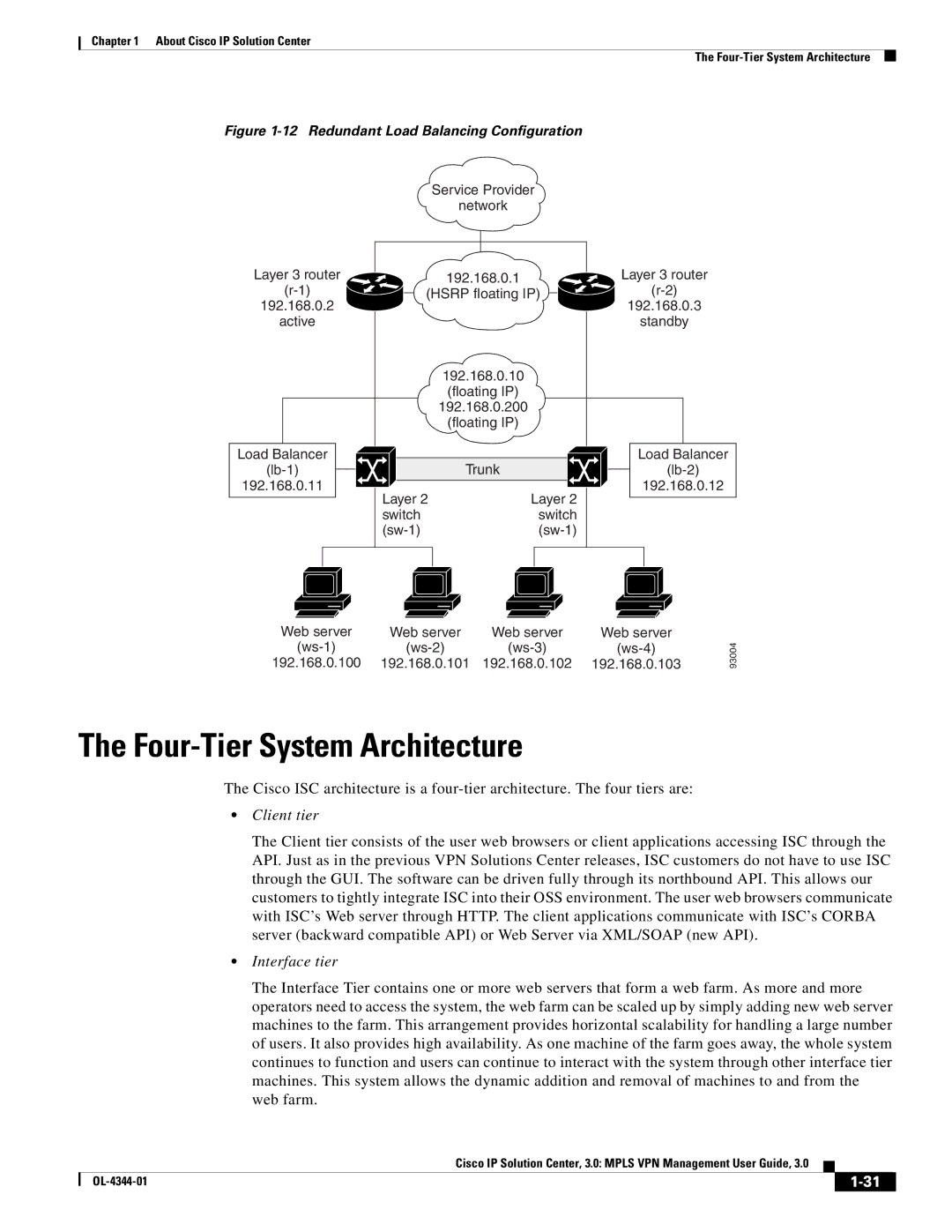
Chapter 1 About Cisco IP Solution Center
The
Figure 1-12 Redundant Load Balancing Configuration
Service Provider
network
Layer 3 router |
|
|
|
|
|
|
|
|
|
| Layer 3 router | ||||||||
|
|
|
|
|
|
|
|
|
| ||||||||||
|
|
|
| 192.168.0.1 |
|
|
|
| |||||||||||
|
|
|
|
| |||||||||||||||
|
|
|
| (HSRP floating IP) |
|
|
|
|
| ||||||||||
192.168.0.2 |
|
|
|
|
|
|
|
|
|
|
| 192.168.0.3 | |||||||
|
|
|
|
|
|
|
|
| |||||||||||
active |
|
|
|
|
|
|
|
|
|
|
|
| standby | ||||||
|
|
|
|
|
|
|
|
| 192.168.0.10 |
|
|
|
|
|
|
|
|
| |
|
|
|
|
|
|
|
|
| (floating IP) |
|
|
|
|
|
|
| |||
|
|
|
|
|
|
|
|
| 192.168.0.200 |
|
|
|
|
|
|
|
|
| |
|
|
|
|
|
|
|
|
| (floating IP) |
|
|
|
|
|
|
| |||
|
|
|
|
|
|
|
|
|
|
|
|
|
|
|
|
|
|
| |
Load Balancer |
|
|
|
|
|
|
|
|
|
|
|
|
| Load Balancer | |||||
|
|
|
|
|
|
|
|
| |||||||||||
|
|
|
|
|
| Trunk |
|
|
|
|
| ||||||||
|
|
|
|
|
| ||||||||||||||
192.168.0.11 |
|
|
|
|
|
|
|
|
|
|
|
| 192.168.0.12 | ||||||
|
|
| Layer 2 |
| Layer 2 |
|
| ||||||||||||
|
|
| |||||||||||||||||
|
|
|
|
|
|
|
|
|
|
|
|
|
| ||||||
|
|
|
|
|
|
|
|
|
|
|
| ||||||||
|
|
|
|
|
| switch |
|
| switch |
|
|
|
|
|
|
| |||
|
|
|
|
|
|
|
|
|
|
|
|
|
|
| |||||
|
|
|
|
|
|
|
|
|
|
|
|
|
|
|
|
|
|
|
|
|
|
|
|
|
|
|
|
|
|
|
|
|
|
|
|
|
|
|
|
Web server | Web server | Web server | Web server |
192.168.0.100 | 192.168.0.101 | 192.168.0.102 | 192.168.0.103 |
The Four-Tier System Architecture
The Cisco ISC architecture is a
•Client tier
93004
The Client tier consists of the user web browsers or client applications accessing ISC through the API. Just as in the previous VPN Solutions Center releases, ISC customers do not have to use ISC through the GUI. The software can be driven fully through its northbound API. This allows our customers to tightly integrate ISC into their OSS environment. The user web browsers communicate with ISC’s Web server through HTTP. The client applications communicate with ISC’s CORBA server (backward compatible API) or Web Server via XML/SOAP (new API).
•Interface tier
The Interface Tier contains one or more web servers that form a web farm. As more and more operators need to access the system, the web farm can be scaled up by simply adding new web server machines to the farm. This arrangement provides horizontal scalability for handling a large number of users. It also provides high availability. As one machine of the farm goes away, the whole system continues to function and users can continue to interact with the system through other interface tier machines. This system allows the dynamic addition and removal of machines to and from the web farm.
Cisco IP Solution Center, 3.0: MPLS VPN Management User Guide, 3.0
|
| ||
|
|
